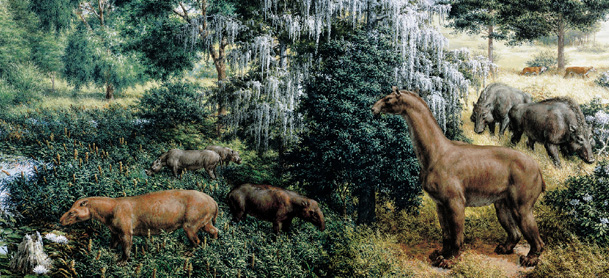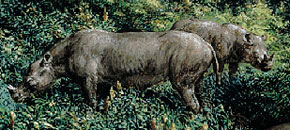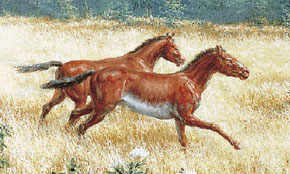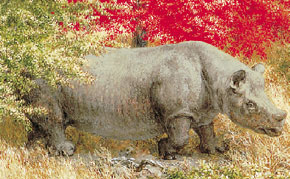Miocene
Miocene Epoch (23 – 5.3 MYA)

An extract from Rudolph F. Zallinger’s mural “The Age of Mammals,” showing reconstructions of Miocene mammals. From left to right these are Promerycochoerus, an oreodont artiodactyl; Menoceras, a small rhino with paired horns on its snout; Merycochoerus, a second genus of oreodont; the chalicothere Moropus; and the giant entelodont artiodactyl Dinohyus. © Yale University
The Miocene was a long-lasting epoch in which the earth's climate rebounded from the cooling of the Oligocene and there was a marked increase in both global temperatures and the total number of mammal species.
Though warmer than the Oligocene, the polar ice caps remained in place. India collided with Asia, causing a massive upthrust of the Asian continent that created the Tibetan plateau and the Himalayas. As Africa moved northwards to link with Europe, the Tethys Sea, a vast seaway that once existed between the two continents Europe and Africa, disappeared.
As the Miocene progressed, the earth began to cool once more; the climate became more arid and mammalian diversity began to decrease again. Grasslands underwent a major expansion in the early Miocene and mammalian herbivores, including equids, rhinos, and many artiodactyls, had to evolve a variety of new adaptation to cope with the more open and arid habitats and coarser vegetation. It is not uncommon to find many species of horses coexisting in the Miocene. In addition to horses, the Miocene mammal faunas of North American were dominated by rhinos, such as Teleoceras, a large variety of camels, extinct relatives of elephants called gomphotheres, “bone-crushing” borophagine dogs, and cat-like saber-toothed predators known as nimravids.
There are many more fossils from the Miocene than for previous time periods and Miocene fossils are known from a greater number of geographic regions; for example, Miocene fossils are abundant in Africa, while there are very earlier fossils from that continent. The drop in sea levels during the Miocene associated with the growth of polar ice caps led to the first exposure of what is now Florida in the Miocene, and an extensive fossil record of horses and other Miocene mammals is preserved there. Miocene fossil mammals are found across a wide range of localities in the USA, including California, Nebraska, and Texas.



